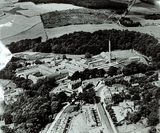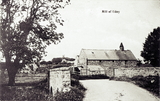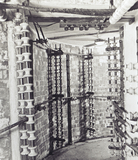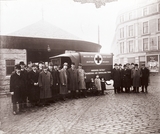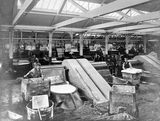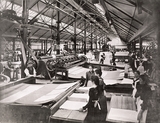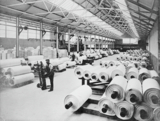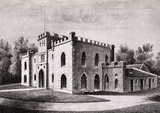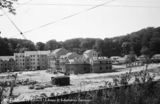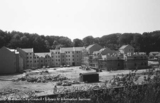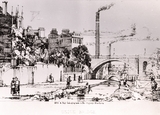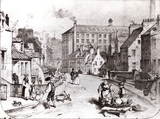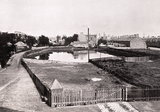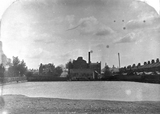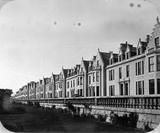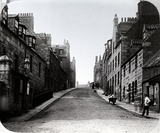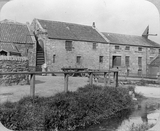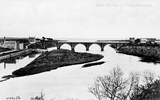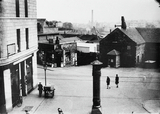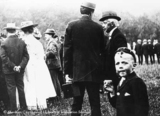|
Quick Search
|
Search Results
You searched for: More Like: 'Donside Paper Mill'
169 items
items as
Culter Paper Mills
163 Culter Paper Mills, the oldest paper mill in the Aberdeen area, having been founded in 1750 by Bartholomew Smith.
The Gordon Arms Hotel can also be seen in the lower right of the image. Mill of Udny
208 This postcard image, looking west, shows the Mill of Udny, located not far to the south east of Pitmedden, next to the Bronie Burn. This photograph likely dates from the early 20th century.
The large building shown here, which old OS maps indicate was a corn mill, is still there at the time of writing in 2022. As is the bridge over the Bronie Burn, though its walls appear to have been lowered.
The Mill of Udny is located on a small road, running east to west, between Housieside and Udny Green. The original buildings have been added to and it is now the site of the Mill Business Centre. Aberdeenshire: Donside and Strathbogie, an Illustrated Architectural Guide (2006) by Ian Shepherd indicates that this conversion took place in 1991.
A waterwheel can be seen on the southern side of the mill in this image. Early 20th century OS maps indicate this was powered by a lade, diverted from the Bronie Burn, that ran through the field to the west. A mill dam was once located to the south west across the field.
This image features in the book Old Udny, Tarves and Methlick (2007) by Donna M. Donald. In accompanying information the author states that in 1800 the mill was one of ten working in the Udny area. Donald also states that the mill was built in the middle of the 18th century, "by a forward-thinking laird", and remained in operation until the 1920s. The entrance to a Cable Subway, Aberdeen Electricity Works, Millburn Street. c.1905
313 In 1889, Aberdeen Town Council received the first applications by companies wishing to supply electricity . They decided to operate their own system, which was inaugurated in 1894 at Cotton Street. The rapid increase in demand led to the purchase of a new site in 1901 and Aberdeen Electricity Works at Millburn Street were built. In 1895 nearly 160,000 units were generated, rising to 5 and a half million by 1907. This photograph shows the entrance to the Cable Subway running from the works in the line of Crown Street and Justice Mill Lane for 1500 yards. It was capable of accommodating all the feeder cables required for the northern and western districts of the city, and was believed to be the largest of its kind in the UK. When the Electricity Act of 1947 came into force on 1st April 1948, generation of electricity transferred to the North of Scotland Hydro Board. Red Cross Ambulance
364 A photograph from the presentation of a new ambulance by Aberdeen District engineering and shipbuilding firms to the Scottish Branch of the Red Cross Society on Monday 29th January 1917.
The vehicle, funded by subscription, was for use in Aberdeen and was handed over to Colonel J. Scott Riddell, the Red Cross Commissar. He can be seen fourth from the left in the group on the right.
The leftmost figure of that grouping is Lord Provost James Taggart. He presided over the presentation event that took place in the Red Cross Transport Headquarters on Holburn Street, visible here in the background. Taggart was a granite sculptor by trade and had a works nearby at 92 Great Western Road.
The location of this photograph is at the junction of Justice Mill and Holburn Street. A branch of the Summerhill Farm Dairy is visible in the background.
An account of the presentation and a list of subscribers can be read on page 3 of The Aberdeen Daily Journal for 22nd January 1917. Rubislaw Supply Stores
372 This building was erected in 1837 as a tollhouse on the Aberdeen-Skene turnpike road. Turnpike roads were built during the late 18th and early 19th centuries with the intention of improving the rough tracks which were the only roads at that time. Income for the maintenance of the roads was administered by local trustrees through a levy of tolls on travellers at bars or gates, usually set at 6 mile intervals. At each bar there was a tollhouse where the keeper lived. The rounded shape with windows facing in different directions allowed the tollkeeper to see who was approaching so that he could collect the tolls. The toll system was abolished by the Aberdeenshire Roads Act, 1865. The Rubislaw Toll House was then converted into a grocery shop and became known as Rubislaw Supply Stores, run for many years by Gavin Coutts. It remained as a grocery store until recently when it has been converted into a restaurant. It stands at the junction of Queens Road and Spademill Road - named from an old mill which turned wooden handles for spades in the late 1700's. Stoneywood Paper Mills
389 A photograph showing an interior view of Stoneywood Paper Mills. The image shows a large hall full of workers and machinery producing large sheets of paper. The Barracks, Woodside
440 A factory worker had a hard working day with the day beginning as early as 5.30 same days, wages were also very poor. Woodside works built housing across the field from the mill to house apprentices. The building was known as the Barracks and also Persley Castle. It later served as a residential care home. The Denburn Valley, showing Union Bridge
691 The Denburn Valley, showing Union Bridge. The chimney belonged to Hadden's textile mill in the Green. Gilcomston Dam
706 Once fed by the waters of the Denburn on its eastward course from Kingswells and Rubislaw Den, the Gilcomston Dam lay between Leadside Road and the present Osborne Place. It was in existence as early as 1673, when it is mentioned in a disposition of sale of surrounding land to the Aberdeen Corporation, and in the sale, the meal mill of Gilcomston is mentioned. The dam was drained and filled in by the Town Council in 1907 as it had become insanitary and a favourite place for drowning cats and dogs. Gilcomston Dam
707 Once fed by the waters of the Denburn on its eastward course from Kingswells and Rubislaw Den, the Gilcomston Dam lay between Leadside Road and the present Osborne Place. It was in existence as early as 1673, when it is mentioned in a disposition of sale of surrounding land to the Aberdeen Corporation, and in the sale, the meal mill of Gilcomston is mentioned. The dam was drained and filled in by the Town Council in 1907 as it had become insanitary and a favourite place for drowning cats and dogs. Rubislaw Terrace, Aberdeen
709 Rubislaw Terrace, Aberdeen in around 1880. This photograph by George Washington Wilson shows the granite splendour of this terrace, which was planned by the architects Thomas Mackenzie and James Matthews, jointly with James Giles, artist.
The houses were to be erected on the property of James Skene of Rubislaw, on the north side of Albyn Place. The Aberdeen Journal of 31st March 1852 describes the plans as thus: "The style of architecture possesses in a high degree the rare merit of combining what is new, at least in Aberdeen, with what is, in point of taste exceedingly beautiful".
The houses have crowstepped gables and plain windows alternating with bow windows which have a balustrade, and had 11-15 rooms.
In 1854, James Matthews actually lived there, and later occupants included a paper manufacturer, a ship owner, and a number of advocates.
Today, many of the houses have been converted into offices for legal firms. Granite balustrades and a garden area separate the terrace from Albyn Terrace. Jack's Brae
710 A photograph looking north west up Jack's Brae, from its junction with Upper Denburn, in the Rosemount area. Jack's Brae was named after the owner of property there. This photograph likely dates from the mid-to-late 19th century.
The Ordnance Survey town plan of Aberdeen, 1:500 scale, surveyed in 1866-67 depicts a "Coffee Roasting and Grinding Works" at the top of Jack's Brae at its junction with Leadside Road. A large chimney of these works can be seen on the right side of this image in the distance.
These works were the premises of John Strachan. In the Aberdeen Post Office Directory for 1867-68, Strachan is described as follows:
"Strachan, John, coffee roaster, coffee, sugar, and sugar grinder, Jack's brae" (page 213).
Aberdeen City Council's Historic Environment Record describes the site thusly:
"Site of meal mills, built in the 18th - 19th Centuries and demolished in the 1980s. The works was two-storey with a basement, comprising a 9-bay range with a single kiln and a three-storey with attic 5 by 6-bay block of later date. There were also two 2-storey store blocks. The mill was originally water powered, later electrically driven. The OS 1st edition map depicts a coffee roasting and grinding works here; they are annotated as corn mills on the OS 25in map published 1924." (link here).
The business was known as John Strachan & Sons and the works as Gilcomston Mill. The business was started in around 1852 and John Strachan was succeeded as its proprietor by his son James Strachan (1838-1914). His obituary can be found in the Evening Express of 28th December 1914, page 5. His son, John Strachan, was later to become the business's managing director. The obituary of this later John Strachan can be found in the Press & Journal of 1st July 1935, page 8.
At the time of writing in 2022, the site is occupied by a residential complex called Strachan Mill Court - no doubt named after the coffee roasting and milling enterprise. Lower Justice Mill, Union Glen
810 Justice Mills of one kind or another are first mentioned in the 1300s, and were the site of a famous battle. In their final form, an Upper Justice Mill occupied a site later partially covered by the Odeon Cinema building, while the Lower Mill stood in Union Glen, at the bottom of the steep slope with its mill dam above and behind it (see water wheel centre left). The left hand part of the building and the wheel were removed when the cinema was built, the dam was drained and a thoroughfare created into Union Glen, but the central and right hand parts survived, albeit derelict, into the 1960s.
The wagon in front of the buildings is painted with the business name James Alexander & Son, Grain Merchants. The 1866-67 Ordnance Survey large scale town plan of Aberdeen indicates that Lower Justice Mill was a corn mill.
A black cat can also be seen in the centre right of the image and a woman carrying some type of load is in front of the waterwheel.
Correspondent Geoffrey Mann has been in touch to inform us that in 1793 there was a miller at the Justice Mills called George Reid. This information was found from an Old Machar baptismal record for his and Margaret Smith's (his wife) daughter Elizabeth.
Coincidentally, there was another George Reid (1826-1881) who was a partner in the prominent seedsmen and agricultural implement makers, Messrs Benjamin Reid & Co., who had their Bon-Accord Works just to the east of the Justice Mills. The obituary of this later George Reid from The Aberdeen Journal 16/07/1881 states that at the time his death he lived with his two sisters in Justice Mill Lane. Wellington Lodge
811 A photograph showing Wellington Lodge on the corner of Justice Mill Lane and Holburn Street.
The top of Holburn Street, towards Holburn Junction, was previously known as South Street and later as Wellington Place. In the background of this image, on the far left, can be seen the John Smith designed Water House on Union Street.
Wellington Lodge stood across the road from Holburn Church, roughly where the Glentanar Bar stands today. It can be seen on the large scale Ordnance Survey town plan and map sheets from the 1860s.
The property appears to have belonged to the Whytes of Dalhebity, Cults. For some time Wellington Lodge was the residence of Helen Whyte and she was likely the house's final resident.
Helen Whyte died aged 85 on 31st January 1898 (death notice: Aberdeen Weekly Journal, 09/02/1898, p. 4). Newspaper references suggest she was involved in various charitable activities. She was the daughter of Baillie John Whyte, a merchant, and had a brother also called John Whyte (1845-1904), a prominent citizen and advocate.
Another death notice indicates that Mary Ann Hardie, of 48 Victoria Road, Torry, was employed for 38 years as the servant for Miss Helen Whyte. Hardie died in 1895 (death notice: Aberdeen Journal, 17/08/1895, p. 4).
Newspapers also suggest the villa was the home of Miss Mary Murray Gordon. She would likely have been a relation of James Murray Gordon who was a partner in the same law firm as John Whyte, Helen's aforementioned brother.
Wellington Lodge was probably demolished shortly after the death of Helen Whyte. It made way for the extension of the larger tenement buildings on Holburn Street that can be seen in the background of this photograph.
The Aberdeen Weekly Journal's 'Granite Chips' column of 17th May 1899 (p. 9) states "A very large and handsome block of buildings for Mr Peter Farquharson has been erected in Holburn Street, stretching from the office of the Union Bank of Scotland to Justice Mill Lane." This most likely refers to this development.
David Miller in Archibald Simpson, Architect, His Life and Times 1790-1847 (2006) states that this villa was designed by Simpson for Mrs Yeats of Auquharney (page 174). New Bridge of Don, Aberdeen
831 A James Valentine postcard image looking east towards the Bridge of Don in Aberdeen with the river mouth beyond.
The photograph used on this postcard likely dates from the early 20th century. The lone building at the left end of the bridge would be the Donview Hotel.
The buildings on the far left, down the path from the hotel, are likely those of Don Mills, which processed corn and barley. Aberdeen City Council's Historic Environment Record states that the mill was originally built as a distillery in 1798. Justice Mill Lane
863 Justice Mill Lane, off Holburn Street, prior to the building of the Regent/Odeon Cinema (1932) and the Bon Accord Baths (1940).
This image looks east on to Justice Mill Lane from Holburn Street. The building on the right is one of the old mills that were present in the area. To its left is the premises of James Scott, a tobacconist.
In the near right of the image is the side of 35-39 Holburn, a tenement that likely dates from 1899. The ground floor of this building has been occupied for much of its history, and in this photograph, by the Glentanar Bar.
The Aberdeen Pub Companion (1975) by Archibald Hopkin states that the Glentanar dates from 1909 when Charles Ewen acquired a licence for the premises at 39 Holburn Street.
The structure in the centre of the image is the ornate ventilation shaft of the Aberdeen Cable Subway. It was constructed as part of the Dee Village Electricity Works, at the foot of Crown Street, and dates from around 1903. Culter
876 This image was taken around 1909 from a hill at the west end of Culter - 7 miles west from Aberdeen looking down on the North Deeside Road towards Banchory. The image shows the cottages known as Clayhills with the houses of Malcolm Road beyond. Hidden in the trees at the right hand side is the statue of Rob Roy overlooking the Leuchar Burn which runs through the wooded valley. |



